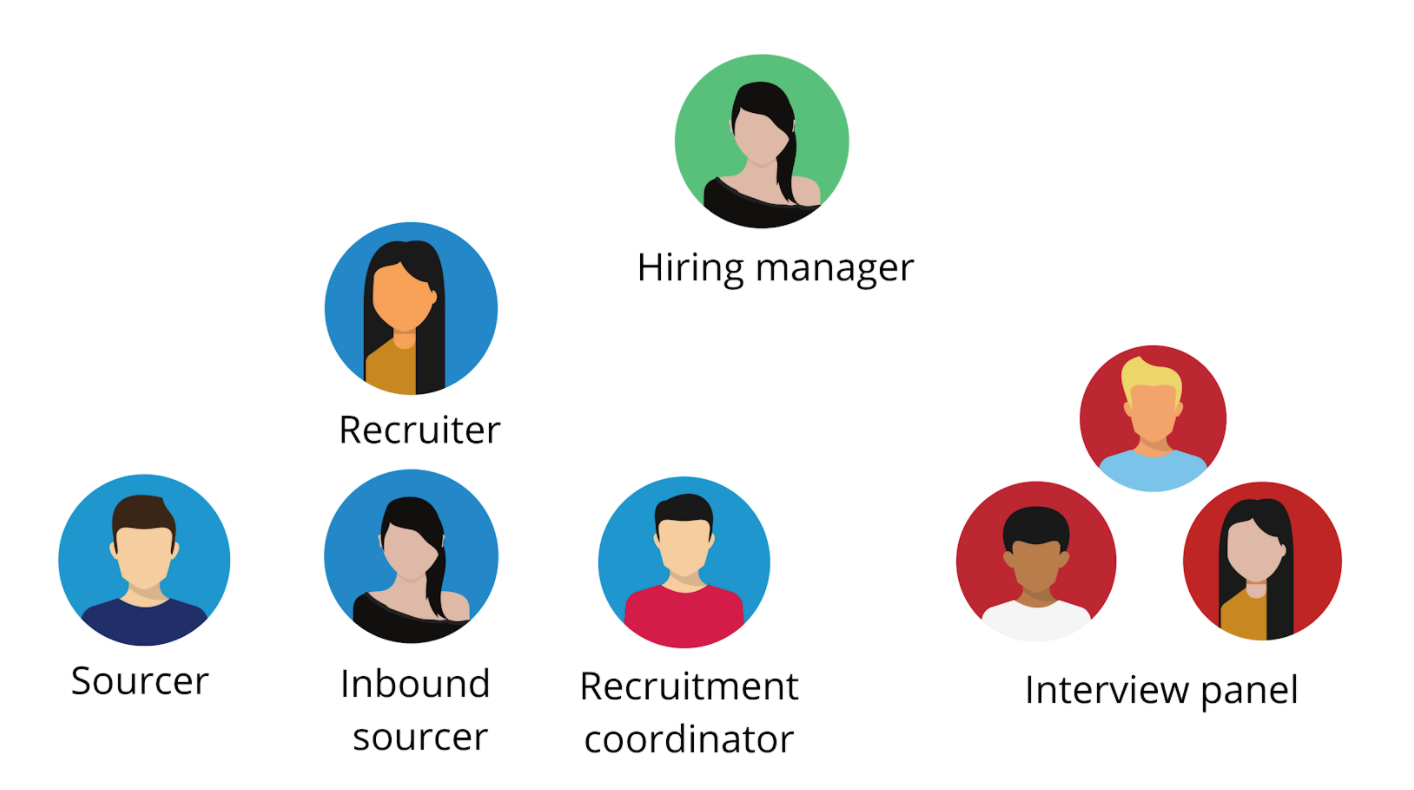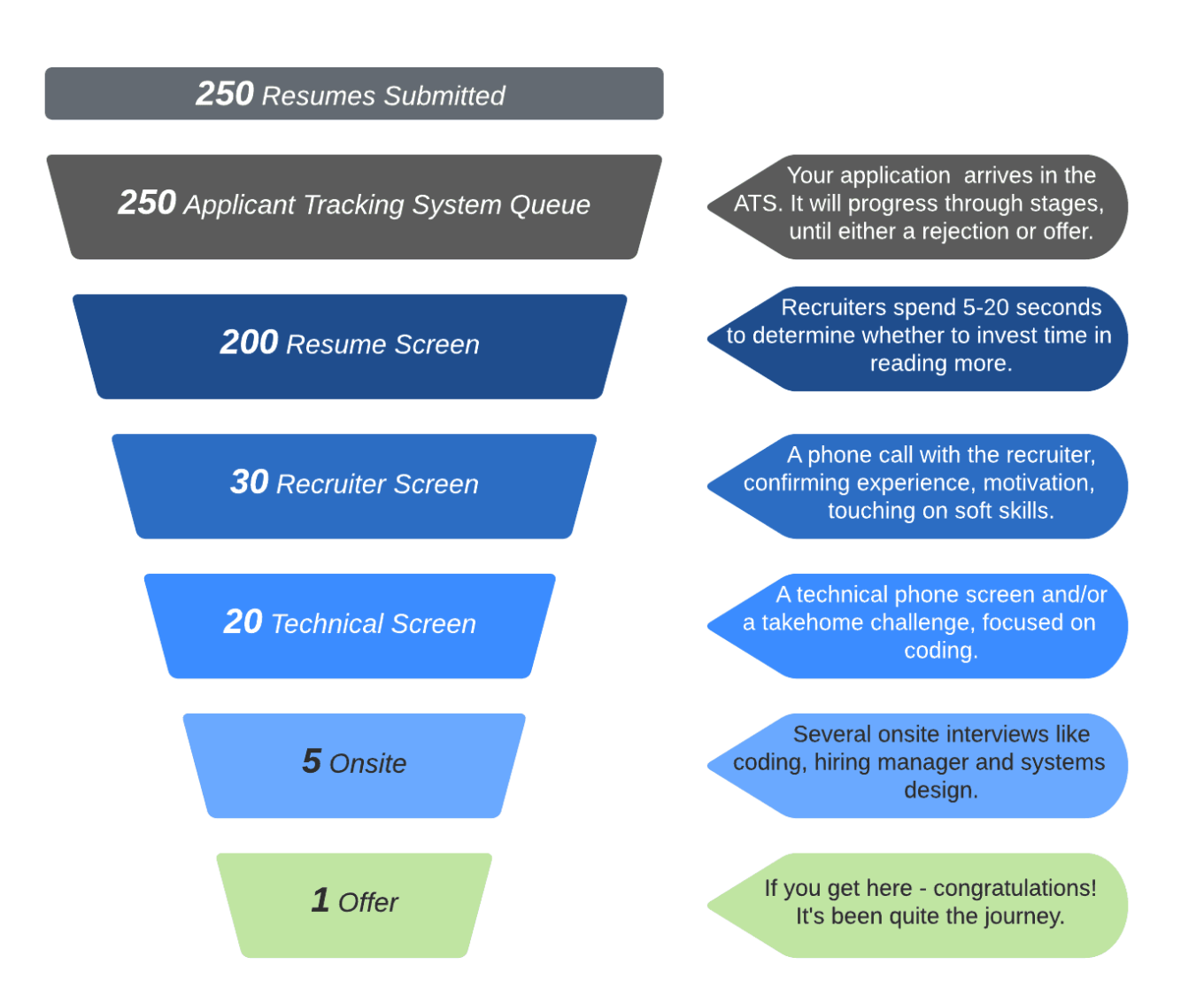The below sections are part of Chapter 2: The Hiring Pipeline in The Tech Resume Inside Out book.
Let's look at the bigger picture of what the interview process looks like, to better understand why a good resume is so important. This process can often seem like a black hole. It could also feel like a hard-to-predict series of interactions with people until you—hopefully—get an offer.
Hiring managers and recruiters look at this process quite differently and call it the Hiring Pipeline. Why this name? It's because at every stage, there's a significant dropoff in the number of candidates still in the pipeline.
Throughout the hiring process, you’ll interact with several people. Still, there are even more whom you might not be aware of. Let’s take a look at each of the roles, their goals, and why you should care about these.

People in the recruitment process, from the hiring manager, through the recruiter, all the way to inbound sourcers, recruitment coordinators and sourcers.
How does knowing about these roles help you in a job application process? It places things into perspective. For example, many candidates don’t assume that both the recruiter and the inbound sourcer are fundamentally on their side. Both of these people need to make hires to hit their goals. However, they need to balance the expectations set by the hiring manager. If the hiring manager explicitly asked for certain technologies or certain years of experience, they will most likely follow this guidance.
Similarly, it’s good to know that when you get a LinkedIn reach-out, it’s from a sourcer. However encouraging you’ll find things they say about your profile, these people want to get you in the hiring pipeline, and you don’t have a job “guaranteed”. You’ll still have to go through the interview process.
When you interact with people, be mindful of these roles and their constraints. When a recruiter messages or calls you about a rejection, know that they are often a messenger. They are as invested in you getting the job as you are! As much as both the resume screening and the interview process can seem like a black box, it’s run by people who try and do their best.
Blake Stockman, who recruited for Google, Facebook, Uber, Flexport and other Silicon-Valley startups, explains how recruiters come in all shapes and sizes, and how your experiences can vary wildly between companies and recruiters.
The thing about the field of recruiting is that it’s not one that people plan to get into. If you talk to anyone in the recruiting field, you’ll find a wide variety of how people got here. This is in contrast to, for example, software engineering, where it typically takes a computer science degree, or some other technical degree to get started. No matter how you get into the software development field, it’s rarely an accident: you plan and prepare for a very long time. With recruiting, people typically just find themselves in this industry.
As a result, you have a variety of backgrounds and expectations. You also find a varied level of quality with recruiters. This makes it hard to find that top tier recruiter who’s going to help you really navigate that process well. Someone who will be your advocate, and someone who will give you a true view of what’s going on.
What you should expect, and what the baseline should be to hope for, is a level of transparency of what’s going on. To understand who this person’s stakeholders are. For example, at a large company, like Google or Facebook, I would have a level of relationship with hiring managers, but it was really abstract. I was more of an administrator of the existing recruitment process. Here, all I could do was communicate to candidates what the process was, and what I was going to do on their behalf, as they made their way through the process.
Whereas when I was at Uber, I was working with hiring managers directly on actually crafting what that recruitment process was, specifying the outputs of interviews. In this case, I was able to tell candidates what to expect at the level of focus areas—without giving away the exact questions themselves. Things like how there will be the coding, architecture, and hiring manager interview. How interviewers will want to know about your thought process, how outcome-oriented you are, how process- or thinking-oriented you are, and how they’ll dive into collaborative problem solving with you.
Generally speaking, the smaller the company is, the more details you should be able to get, and the deeper the relationship should be with your recruiter. So when you work with recruiters at startups, you’ll get a much clearer view and a much deeper lens. You’ll get a better idea of the culture, what’s actually happening there, what teams are looking for, and what to expect.
Of course, a lot depends on the actual recruiters. Some of the best recruiters I know are working at larger companies, and many of the ones at smaller companies are just getting their careers started. So you will have a high level of variance.
When you submit your resume through a job advert, the typical hiring pipeline is similar across all tech companies. There’s a resume screen, a recruiter screen, a technical screen and a series of onsite interviews. You could get rejected at each round—or, if you did well, progress until you get an offer. Here is how this hiring pipeline could look, visualized:

A typical hiring pipeline at a large, well-known tech company. The actual process, and numbers will vary on a role-by-role, company-by-company basis.
Let's look at each of the stages:
1. Applicant Tracking System Queue. Almost all tech companies use an Applicant Tracking Systems (ATS). These systems track the lifecycle of your application. For example, after a recruiter reviews the resume, the status of the candidate might change to “Reviewed” or “Resume Reviewed.”
Not all applications might progress to the resume review screen. The reason some applications might not be looked at that there are already enough qualified resumes in the previous batch. Another reason could be that the position has just been filled. In general, the later your resume comes in, the higher the chance that it won’t be looked at, due to having enough qualified candidates in further stages of the pipeline. With better companies, candidates would still get a standard rejection notification when their application is not processed further.
2. Resume / CV screen. In most companies, recruiters do the resume screening. However, some larger companies, particularly Silicon Valley-based ones, tend to have a specialized role called inbound sourcer, who takes on this screening. The recruiter or inbound sourcer scans your resume, spending 5-20 seconds to determine if you might be a match for the position. If you're not a good match, you might get an automated rejection message—assuming the company has a policy to send one. If the first scan is promising, they'll spend a bit more time reading your resume in depth. Afterwards, they might set up an initial call to check on a few details, and determine if they'll have you start the interview process.
The dropoff is usually the steepest at this step. From hundreds of resumes, only a few dozen profiles tend to have a recruiter screening call. This is why it’s important to tailor your resume, so it grabs the attention of the recruiter, or the hiring manager at this point.
3. Recruiter screen. Only profiles who look like a promising fit for the job make it to the recruiter screen. This is a phone call with the recruiter, confirming experience, motivation, and touching on soft skills.
4. Technical screen. A technical phone screen and/or a take-home challenge focused on coding. Candidates almost always interact with software engineers at the company at this point.
5. Onsite interview. Several onsite interviews such as coding, hiring manager and systems design. The hiring manager interview usually looks for soft skills, culture match and values alignment. Systems design interviews are usually scheduled only for more experienced candidates.
6. Offer. It’s common for a funnel that started with 100+ qualified resumes to result in a single offer. If you do get an offer, massive congratulations—you probably had little clue until now just how competitive this process was.
Get The Tech Resume Inside Out and carry on reading this chapter, with the sections:
Congrats to @GergelyOrosz on getting this book out there. I have read many good and not so good resumes over my career, so this advice will be useful. Also on offer for free for those looking for a job, helpful in these times 👏 https://t.co/SqnyRLwoOl
— Pat Kua (@patkua) October 9, 2020











